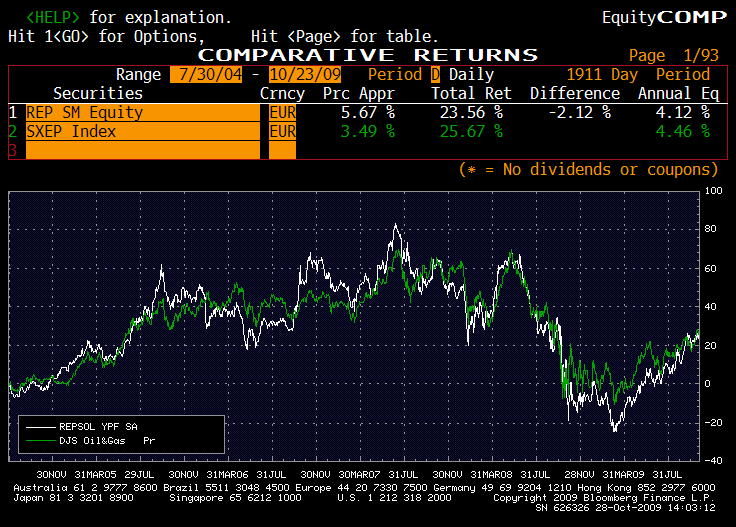(Published in Cotizalia on Oct 29th 2009)
Interesting times for Repsol, with plenty of corporate rumors.
Since 2004 the company has focused primarily on controlling capex, in a group that needed to invest more than € 6 billion annually, almost 25% of its market capitalization to keep the net income flat, and find ways to sell YPF, trying to reduce the high exposure to Argentina, almost 40% of its assets. A similar problem to that of OMV in Romania, and to a lesser extent, BP with TNK (Russia). Still, the stock has behaved almost exactly with the rest of the industry, thanks to its exposure to Brazil, Venezuela, Sierra Leone and other assets of high exploration potential, which enabled it to be one of the few who will to replace 100% of its reserves in 2009. This despite the capital increase of Gas Natural Gas and Repsol’s Refining business unit, highly capital intensive and of low added value.
One hears rumors of a possible dividend cut, but this does not only affect Repsol. The industry tries to maintain a proper debt to the underlying asset, given its cyclical nature, can not afford adventures on its balance sheet. See the case of ENI, or OMV, with capital increase of € 1,000 million added.
The challenge of Repsol, and the integrated oil sector, is to create shareholder value, and that’s difficult in a sector as poorly differentiated. The integrated model has traded for years at 9-11x PE, with a discount on the sum of the parts which at the top of the cycle reaches 20% and at the bottom reaches 30%. A large discount to E&Ps or specialized services firms, for example, but also a lower-risk model due, in part, to the lower debt. It is difficult, as investor, to demand high multiples and dividend stability while seeking large investments and long term perspectives. More difficult, moreover, if Repsol requires € 3 billion per year in maintenance investments and € 15 billion to develop the fields of Brazil, since it has less margin than others, and needs high oil prices and refining margins much higher to generate free cash while developing these assets.
The stock appreciation of an oil company can only come from increasing the return on capital employed, which requires specialization and strict control of the return on investment, and crystallize value by separating assets. So it’s worth trying to sell YPF, refineries or Gas Natural with a premium, but it’s not easy, and political issues do not allow it in certain cases.
Repsol has before it the challenge of deciding what it wants to be in the next ten years. As British Gas or GALP are proving, it can not be in the whole energy chain at a time and maximize value in their growth areas. Controlling costs, develop the business of exploration and production, manage the portfolio of assets to avoid having more than 15% in each country, and reduce exposure to refining and regulated activities remains the appropriate strategy. If not, they must wait for the miracle of the expansion of multiples of the entire sector. And that is risky.
